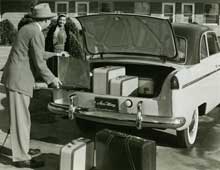Excess Baggage
Willys-Overland eagerly touted the luggage capacity of the new Aero models in 1952: "24 cubic feet of space - ample for a large family." They even bragged about the primitive exterior hinges: "outside where they can't bite into luggage." That's quite remarkable for what was a comparatively small car; the Packard Patrician rated but 30 cubic feet.
We take luggage capacity pretty much for granted, forgetting that early cars had none at all. Any passenger suitcases had to go on the roof or behind racks on the running board. The first "indoor" luggage space was the trunk, just that, a steamer trunk fastened to the rear of the car. By the early 1930s, automakers started to provide inside storage with an outside door; by mid-decade the "touring trunk" became popular, though the first ones, like this 1935 Hudson, were top loading.
Our Ford Falcon wagon was a vast cavern, more than adequate for our "large family" of five. Just as adequate, it turned out, was its successor, a 1970 Chevy Impala, another 30-cubic-footer (by GM's calculation - Automotive Industries counted its "usable luggage space" barely half that). The Chevy Suburban that replaced it, first in a long succession of Foster 'Burbs, made capacity almost irrelevant.
If luggage-measuring systems are comparable, today's cars are puny by Packard or Impala standards. The Lincoln Town Car counts only 21 cubic feet of space, though it's not the largest American sedan trunk. Perhaps surprisingly, that distinction goes to the Ford Five Hundred/Mercury Montego twins with 21.2. Not enough space? You can still put things on the roof.
Need a trunk for your old car? You can find one at Hershey. At Beaulieu Autojumble you can also find vendors of vintage luggage to put on your vintage roof.

